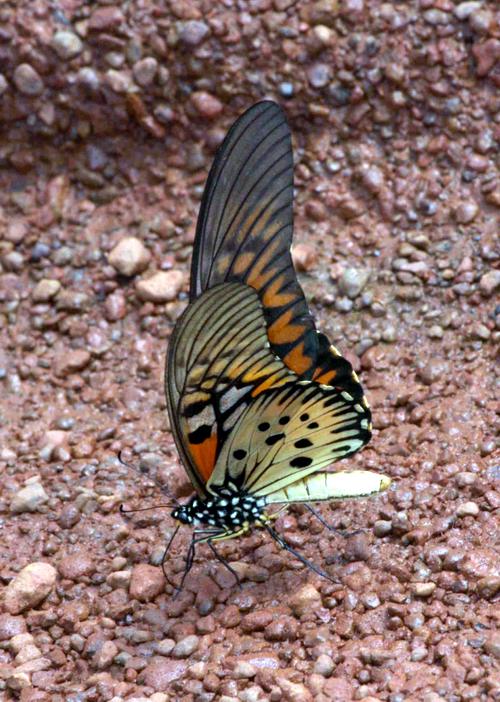
Redwood National Park
Redwood National Park is home to the tallest trees in the world the coast redwoods (Sequoia sempervirens). Redwood National Park was established in 1968, and is home to old-growth coast redwoods (Sequoia sempervirens). Coast redwoods can grow to nearly 400 feet tall and live to be 2,000 years old. Redwood National Park has a mosaic of habitats that includes prairie and oak woodlands, spruce, hemlock, Douglas-fir, berry bushes, and sword ferns understory. This national park also features two rivers, the Smith River and Klamath River, various small streams, and nearly 40 miles of pristine Pacific coastline.
Redwood National and State Parks were designated a World Heritage Site on September 5, 1980 and have also been designated an International Biosphere Reserve.
Redwood National Park is home to a wide range of mammal species ranging from the tiny shrews to the Roosevelt elk, weighing over a half a ton. Once almost extinct in California, the Roosevelt elk is now making a comeback Redwood National Park.
More than 65 terrestrial mammals species are found in Redwood National Park. Many of these mammals reside in the national park year-round; however some, such as several bat species, reside in the national park only during the breeding season or during migration.
The following are some of the mammal species found in the Redwood National Park:
Virginia oppossum (Didelphis virginiana) – non-native
Marsh shrew (Sorex bendirii)
Pacific shrew (Sorex pacificus)
Trowbridge shrew (Sorex trowbridgii)
Vagrant shrew (Sorex vagrans)
American shrew-mole (Neurotrichus gibbsii)
Broad-handed mole (Scapanus latimanus)
Coast mole (Scapanus orarius)
Townsend’s mole (Scapanus townsendii)
Big brown bat (Eptesicus fuscus)
Western red bat (Lasiurus blosevillii)
California myotis (Myotis caifornicus)
Fringed myotis (Myotis thysanodes)
Little brown myotis (Myotis lucifugus)
Long-eared myotis (Myotis evotis)
Long-legged myotis (Myotis volans)
Yuma myotis (Myotis yumanensis)
Hoary bat (Lasiurus cinereus)
Silver-haired bat (Lasiurus noctivigans)
Townsend’s big-eared bat (Corynorhinus townsendii)
Pallid bat (Antrozous pallidus)
Mexican free-tailed bat (Tadarida brasiliensis)
Brush rabbit (Sylvilagus bachmani)
Mountain beaver (Aplodontia rufa)
Chipmunk (Tamias sp.)
California ground squirrel (Spermophilus beecheyi)
Douglas squirrel (Tamiasciurus douglasii)
Northern flying squirrel (Glaucomys sabrinus)
Western gray squirrel (Sciurus griseus)
Botta’s pocket gopher (Thomomys bottae)
Bushy-tailed woodrat (Neotoma cinerea)
Deer mouse (Peromyscus maniculatus)
Pacific jumping mouse (Zapus trinotatus)
California vole (Microtus californicus)
Sonoma tree vole (Arborimus pomo)
Red tree vole (Arborimus longicaudus)
Western red-backed vole (Myodes californicus)
Muskrat (Ondatra zibethicus)
American beaver (Castor canadensis)
Porcupine (Erethizon dorsatum)
Coyote (Canis latrans)
Gray fox (Urocyon cinereoargenteus)
Black bear (Ursus americanus)
Ringtail (Bassariscus astutus)
Raccoon (Procyon lotor)
Short-tailed weasel (Mustela erminea)
Long-tailed weasel (Mustela frenata)
Mink (Mustela vison)
Fisher (Martes pennant)
Marten (Martes caurina)
Striped skunk (Mephitis mephitis)
Spotted skunk (Spilogale gracilis)
River otter (Lontra canadensis)
Black-tailed deer (Odocoileus hemionus)
Roosevelt elk (Cervus canadensis)
Bobcat (Lynx rufus)
Mountain lion or cougar (Puma concolor)
Steller sea lion (Eumatopias jubatus)
Sperm whale (Physeter macrocephalus
Killer whale (Orcinus orca)
Humpback whale (Megaptera novaengliae)
Redwood National Park is also home to nearly 300 species of birds, including the whimbrel (Numenius phaeopus), sanderling (Calidris alba), western sandpiper (Calidris mauri), spotted sandpiper (Actitis macularis), western snowy plover (Charadrius nivosus), Caspian tern (Hydroprogne caspia), California brown pelicans (Pelicanus occidentalis), short-tailed albatross (Phoebastris albatrus), double-crested cormorant, pigeon guillemots (Cepphus columba), common murre (Uria aalge), common merganser (Mergus merganser), bald eagle (Haliaeetus leucocephalus), osprey (Pandion haliaeus), peregrine falcon (Falco peregrinus), red-shouldered hawk (Buteo lineatus), red-tailed hawk (Buteo jamaicensis), white-tailed kite (Elanus leucurus), acorn woodpecker (Melanerpes formicivorus), california quail (Callipepla californica), western scrub jay (Aphelocoma californica), western bluebird (Sialia mexican), black-throated gray warbler (Setophaga nigrescens), yellow warbler (Setophaga petchia), American dipper (Cinclus mexicanus), Vaux’s swift (Chaetura vauxi), western meadowlark (Sturnella neglecta), great blue heron (Ardea herodias), Steller’s jay, raven (Corvus corax), Northern Spotted Owl (Strix occidentalis caurina), barred owl (Strix varia) – non-native, wild turkey (Mellagris gallopavo) – non-native, western meadowlark, coot, belted kingfisher (Meaceryle alcyon), marbled murrelet (Brachyramphus marmoratus), as well as, several species of gulls, ducks, grebes, flycatchers and loons.
Reptiles and amphibians found in the parks include the northwestern ringneck snake, northern red-legged frog, Pacific giant salamander, rough-skinned newt and sea turtles, .
There are over 180 freshwater and marine species of fishes found in the national park. including the Coho or silver salmon (Oncorhynchus kisutch), steelhead (Oncorhynchus mykiss), chinook salmon (Oncorhynchus tshawytscha), coastal cutthroat trout (Oncorhynchus clarki), sockeye salmon (Oncorhynchus nerka), chum salmon (Oncorhynchus keta), pink or humpback salmon (Oncorhynchus gorbuscha), Pacific lamprey (Entosphenus tridentatus), western brook lamprey (Lampetra richardsonii), Sacramento suckers (Catostomus occidentalis), Klamath small scale suckers (Catostomus rimiculus), prickly sculpin (Cottus asper), coastrange sculpin (Cottus aleuticus), three-spined stickleback (Gasterosteus aculeatus), and tidewater goby (Eucyclogobius newberryi) and eulachon (Thaleichthys pacificus).
Butterflies found in Redwood National and State Parks include the following:
Family Papilionidae – Swallowtails
Clodius Parnassian Parnassius clodius
Anise Swallowtail (Papilio zelicaon)
Western Tiger Swallowtail (Papilio rutulus)
Pale Swallowtail (Papilio eurymedon)
Family Pieridae – Whites & Sulphurs
Pine White (Neophasia menapia)
Mustard (Veined) White (Pieris napi sequoia)
Cabbage White (Pieris rapae)
Large Marble (Euchloe ausonides)
Sara Orangetip (Anthocharis sara)
Gray Marble (Anthocharis lanceolata)
Orange Sulphur (Colias eurytheme)
Western Sulphur (Colias occidentalis chrysomelas)
Family Lycaenidae – Gossamer-wings
Tailed Copper (Lycaena arota)
Gorgon Copper (Lycaena gorgon)
Purplish Copper (Lycaena helloides)
Golden Hairstreak (Habrodais grunus)
Great Purple Hairstreak (Atlides halesus)
Hedgerow Hairstreak (Satyrium saepium)
Bramble Hairstreak (Callophrys perplexa)
Brown Elfin (Callophrys augustinus)
Western Pine Elfin (Callophrys eryphon)
Nelson’s Hairstreak (Callophrys gryneus nelson)
Gray Hairstreak (Strymon melinus)
Family Lycaenidae – Blues
Western Tailed-Blue (Everes amyntula)
Spring Azure (Celastrina ladon)
Dotted Blue (Euphilotes enoptes bayensis)
Silvery Blue (Glaucopsyche lygdamus)
Greenish Blue (Plebejus saepiolus)
Acmon Blue (Plebejus acmon)
Family Nymphalidae – Brushfooteds
Great Spangled Fritillary (Speyeria cybele eileenae) Zerene Fritillary (Speyeria zerene)
Callippe Fritillary (Speyeria callippe laurina)
Hydaspe Fritillary (Speyeria hydaspe)
Pacific Fritillary (Boloria epithore chermocki)
Family Nymphalidae – Brushfooteds
Northern Checkerspot (Chlosyne palla)
Field Crescent (Phyciodes campestris pulchellus_
Mylitta Crescent (Phyciodes mylitta)
Edith Checkerspot (Euphydryas editha)
Satyr Comma (Polygonia satyrus)
Green Comma (Polygonia faunus)
“Zephyr” Hoary Comma (Polygonia gracilis zephyrus)
California Tortoiseshell (Nymphalis californica)
Mourning Cloak (Nymphalis antiopa)
American Lady (Vanessa virginiensis)
Painted Lady (Vanessa cardui)
West Coast Lady (Vanessa Annabella)
Red Admiral (Vanessa atalanta)
Common Buckeye (Junonia coenia)
Lorquin’s Admiral (Limenitis lorquini)
California Sister (Adelpha bredowii)
Common Ringlet (Coenonympha tullia californica)
Common Wood-Nymph (Cercyonis pegala)
Great Arctic (Oeneis nevadensis)
Monarch (Danaus plexippus)
Family Hesperiidae – Skippers
Silver-spotted Skipper (Epargyreus clarus)
Northern Cloudywing (Thorybes pylades)
Western Cloudywing (Thorybes diversus)
Propertius Duskywing (Erynnis propertius)
Persius Duskywing (Erynnis persius)
Two-banded Checkered-Skipper (Pyrgus ruralis)
Common Checkered-Skipper (Pyrgus communis)
Arctic Skipper (Carterocephalus palaemon)
Juba Skipper (Hesperia juba)
Common Branded Skipper (Hesperia comma mattoonorum)
Western Branded Skipper (Hesperia colorado mattoonorum)
Mardon Skipper (Polites mardon)
Sachem Skipper (Atalopedes campestris)
Woodland Skipper (Ochlodes sylvanoides)
Rural Skipper (Ochlodes agricola)
Common Roadside Skipper (Amblyscirtes vialis)
Other invertebrates found in the national park includes the banana slug (Ariolimax columbianus), western pearlshell mussels (Margaritifera falcata) – the longest living freshwater invertebrate in the world, yellow-spotted millipede (Harpaphe haydeniana), California mussel (Mytilus californianus), purple or ochre seastar (Pisaster ochraceus), aggregating anemone (Anthopleura elegantissima), various limpets (Collisella spp.), flat porcelain crab (Petrolisthes cinctipes), black turban snail (Tegula funebralis), periwinkle snail (Littorina scutulata), hermit crabs (Pagurus spp.), white sea cucumber (Eupentacta quinquesemata), various isopods (Idothea spp.), black leather chiton (Katharina tunicata) and purple shore crab (Hemigrapsus nudus).

















